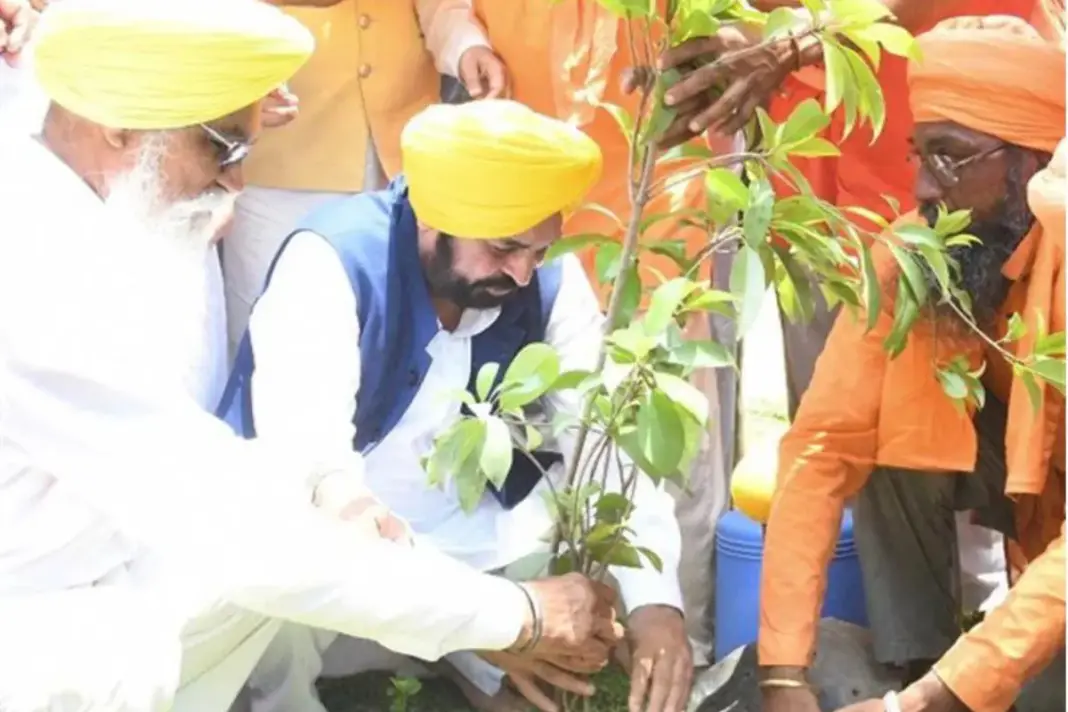The Bhagwant Mann-led Aam Aadmi Party government has made environmental protection one of its key governance missions in Punjab. Under Chief Minister Bhagwant Mann’s leadership, the state has witnessed historic progress in greening efforts over the past two years. In 2023–24 alone, the government planted a record 1.2 crore (12 million) saplings, while setting an ambitious target of 3 crore (30 million) trees for 2024–25. What began as a government initiative has now turned into a people’s movement — a “green revolution” that’s reaching villages, schools, religious places, and cities alike, truly embodying the spirit of “Har Ghar Bagicha” (a garden in every home).
This initiative was much needed for Punjab, as the state’s forest area had been consistently declining over the past two decades. According to a central government report, between 2001 and 2023, Punjab’s forest cover dropped from 4.80% to 3.67%, and tree cover declined from 3.20% to 2.92%. In other words, the state lost 1.13% forest area and 0.28% tree cover in 22 years — clear evidence of how the Congress and Akali Dal governments completely failed to protect the environment. Campaigns like “Greening Punjab Mission” existed only on paper, while results on the ground were almost zero.
The Akali government had claimed in 2012 that it would plant 40 crore (400 million) trees by 2020 at a cost of ₹1,900 crore. However, in reality, only 5 crore (50 million) trees were planted, and merely 25–30% of those survived. This colossal failure exposed that the previous governments’ intentions were not about environmental protection but about publicity and profiteering. Massive advertisements were issued in the name of plantation drives, yet there was no monitoring or maintenance system in place.
Meanwhile, indiscriminate tree cutting further choked Punjab’s air. Between 2010 and 2020, 8 to 9 lakh trees were felled in the name of “development projects.” Alone in 2013–14, 2 lakh, in 2014–15, 2.12 lakh, and in 2010–11, 1.5 lakh trees were cut down. The situation worsened under the Congress government, when then Forest Minister Sadhu Singh Dharamsot was arrested in a forest scam. According to vigilance reports, he took ₹500 bribes per felled kher tree and collected ₹10–20 lakh per officer transfer. This exposed how previous regimes turned Punjab’s greenery into a tool of corruption.
In contrast, the Mann government brought major reforms by implementing the Tree Preservation Policy (2024). This policy ensures protection of trees even on non-forest and government land — no tree can now be cut without permission. It not only safeguards trees but grants them a form of legal “right to life.” Moreover, compensatory afforestation has been made mandatory for every development project. In 2023–24, plantation was carried out on 940.384 hectares under this provision — a solid indicator of Punjab’s environmental recovery.
These efforts have already begun showing tangible results. According to the India State of Forest Report 2023, Punjab’s tree cover has increased by 177.22 square kilometers, marking the largest growth in 15 years. This isn’t just a number — it reflects how, under CM Bhagwant Mann’s leadership, every citizen has become a partner in protecting the environment. Punjab is now moving toward a future where development and ecology go hand in hand.
The Mann government has also intertwined this mission with Punjab’s spiritual and cultural ethos. Inspired by the teachings of Gurbani — “Pavan Guru, Pani Pita, Mata Dharat Mahat” — the state has launched initiatives like ‘Nanak Bagichis’ and ‘Sacred Forests’. So far, 105 Nanak Bagichis and 268 Sacred Forests have been established. These green spaces not only enhance oxygen levels but also serve as “green lungs” for urban areas. Similarly, under the ‘Punjab Hariyali Lehar’ campaign, 28.99 lakh trees have been planted near 3.95 lakh tubewells, making farmers active contributors to this green revolution.
On the global front, the Mann government has partnered with the Japan International Cooperation Agency (JICA) on a ₹792.88 crore project aiming to increase Punjab’s forest area to 7.5% by 2030. This five-year initiative (2025–26 onwards) will not only enhance greenery but also create thousands of new jobs. Through such bold steps, Punjab has emerged as a leading state in environmental conservation across India.
Today, Punjab is witnessing a new green revolution. The trees that were once lost to negligence are being revived. Chief Minister Bhagwant Mann’s message is loud and clear — “Trees are the lungs of Punjab; protecting them is the duty of every Punjabi.” The greenery destroyed by the corrupt regimes of the past is now being reborn under an honest and visionary government. The new Punjab is not just self-reliant in agriculture, but also in sustainability — truly, a “Rangla, Hariyala Punjab.”


